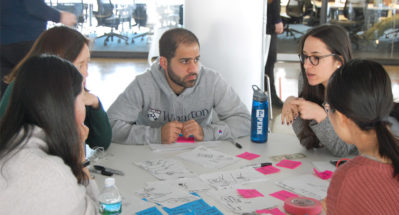
A guest post by Penn student Lila Cohn (IPD’18).
 For those of us who enjoy jetting off to faraway locales, there’s so much to love about travel: exotic landscapes, unfamiliar cultures, fantastic cuisines. But before we can immerse ourselves in our new surroundings, there’s one major hurdle: the travel itself.
For those of us who enjoy jetting off to faraway locales, there’s so much to love about travel: exotic landscapes, unfamiliar cultures, fantastic cuisines. But before we can immerse ourselves in our new surroundings, there’s one major hurdle: the travel itself.
The airport experience, particularly the security check-in process, can be, frankly, awful: awkward, rushed, crowded, stressful… We all want to travel in safety, but can’t we improve this process so it’s more pleasant for everyone involved?
The Spring 2017 Penn Design Challenge tackled just that question. It asked teams of Penn students from Wharton, Engineering, and Integrated Product Design to consider the security experience close to home at Philadelphia International Airport.
Led by Arc Aspicio, a strategy consultancy in Washington, DC specializing in homeland security and transportation security, the five-week sprint presented students with the following task: Enhance the security and safety of people in the Philadelphia International Airport. Consider operational efficiency, customer experience, and security.
The challenge gave us the opportunity to interview staff from the Transportation Security Administration and the Philadelphia International Airport, as well as other airport employees and, of course, travelers. Through two on-site research safaris at PHL, teams gained invaluable insight by interviewing TSA officers and supervisors. We learned first-hand about the challenges that come with their jobs and what the opportunities for improvement might be.
Here are a few other things we learned:
1. The value of a diverse team.
 Our team consisted of two second-year Wharton MBAs, Ivy Wu and Basem Noursi, and two first-year Integrated Product Design master’s students, Zoe Gan and myself. The opportunity to work in a cross-disciplinary setting with teammates from diverse backgrounds played a huge role in our success. Each student brought a different set of skills, interests, and experience to the table, and that was reflected in the diversity of solutions we considered, our ability to challenge and refine the ideas we discussed, and the strength of our final presentation.
Our team consisted of two second-year Wharton MBAs, Ivy Wu and Basem Noursi, and two first-year Integrated Product Design master’s students, Zoe Gan and myself. The opportunity to work in a cross-disciplinary setting with teammates from diverse backgrounds played a huge role in our success. Each student brought a different set of skills, interests, and experience to the table, and that was reflected in the diversity of solutions we considered, our ability to challenge and refine the ideas we discussed, and the strength of our final presentation.
2. Talking to real people in the field is invaluable.
The design challenge gave us the opportunity to sit down with people we may never have come into contact with otherwise, from a lead Transportation Security Officer (TSO) charged with managing the lanes at a checkpoint at PHL, to a supervisor overseeing passenger flow. These conversations allowed us to go beyond the visible elements of the challenge to address the emotional factors that play an implicit role. Our interactions with TSOs and other TSA staff reinforced for us the importance of the human element of the security process, which ended up being the basis for our ultimate solutions.
3. Challenge assumptions at every step.
 We all came into the design challenge with some assumptions. We assumed airport security is a lines-are-too-long problem. Or a taking-off-your-shoes-is-annoying problem. At every step of this challenge, though, we proved our own assumptions to be incorrect–or at least not the whole picture. What we found instead was a compelling human element, where a complex set of relationships and interactions between TSOs and passengers define the security experience on both sides of the x-ray belt.
We all came into the design challenge with some assumptions. We assumed airport security is a lines-are-too-long problem. Or a taking-off-your-shoes-is-annoying problem. At every step of this challenge, though, we proved our own assumptions to be incorrect–or at least not the whole picture. What we found instead was a compelling human element, where a complex set of relationships and interactions between TSOs and passengers define the security experience on both sides of the x-ray belt.
4. The power of a new perspective.
The resources and structure provided by the Penn Design Challenge–direct access to stakeholders, trips into the field, a series of ideation workshops, and final presentations– allowed every team to be fully immersed in the design thinking process. This brought a unique and collaborative angle to the problem, which resulted in innovative solutions across the board and proved to us the value of creativity and collaboration when it comes to solving tough challenges.
The Penn Design Challenge is sponsored annually by the Mack Institute. Sign up here for updates on this and other student opportunities.



